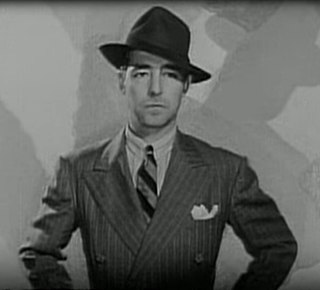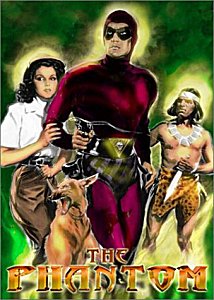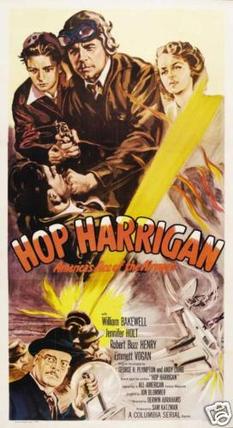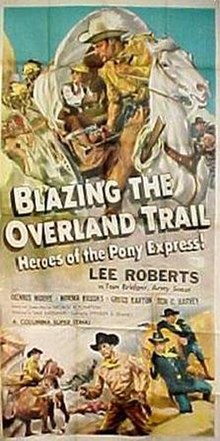
Charles Robert Starrett was an American actor, best known for his starring role in the Durango Kid westerns. Starrett still holds the record for starring in the longest series of theatrical features: 131 westerns, all produced by Columbia Pictures.

Sam Katzman was an American film producer and director. Katzman's specialty was producing low-budget genre films, including serials, which had disproportionately high returns for the studios and his financial backers.

Tom Tyler was an American actor known for his leading roles in low-budget Western films, and for his portrayal of superheroes in movie serials The Adventures of Captain Marvel and The Phantom. Tyler also played the mummy Kharis in 1940's The Mummy's Hand, a popular film in the Universal Monsters franchise.

Kenne Duncan was a Canadian-born American B-movie character actor. Hyped professionally as "The Meanest Man in the Movies," the vast majority of his over 250 appearances on camera were Westerns, but he also did occasional forays into horror, crime drama, and science fiction. He also appeared in over a dozen serials.

Dan White was an American actor, well known for appearing in Western films and TV shows.

The Phantom is a 1943 15-chapter cliffhanger superhero serial, produced by Rudolph C. Flothow, directed by B. Reeves Eason, and starring Tom Tyler in the title role. It is based on Lee Falk's comic strip The Phantom, first syndicated to newspapers in 1936 by King Features Syndicate. The serial also features Jeanne Bates as the Phantom's girlfriend Diana Palmer, and Ace the Wonder Dog as the Phantom's trusted German shepherd Devil.

Spencer Gordon Bennet was an American film producer and director. Known as the "King of Serial Directors", he directed more film serials than any other director.
Frederick Francis Sears was an American film actor and director.

Superman is a 1948 15-part Columbia Pictures film serial based on the comic book character Superman. It stars an uncredited Kirk Alyn and Noel Neill as Lois Lane. Like Batman (1943), it is notable as the first live-action appearance of Superman on film, and for the longevity of its distribution. The serial was directed by Thomas Carr, who later directed many early episodes of the Adventures of Superman television series, and Spencer Gordon Bennet, produced by Sam Katzman, and shot in and around Los Angeles, California. It was originally screened at movie matinées, and after the first three scene-setting chapters, every episode ends in a cliffhanger. The Superman-in-flight scenes are animations, in part due to the small production budget.
The Indians Are Coming is a 1930 American Pre-Code Universal movie serial based on The Great West That Was by William "Buffalo Bill" Cody. The serial was the first "all-talking" film of its kind. It played at The Roxy Theatre and was responsible for saving the film serial format into the sound era.

Overland Mail is a 1942 American Western film serial from Universal Pictures which stars Lon Chaney Jr., Noah Beery Jr. and Noah Beery Sr. It was subsequently edited into a film version called The Indian Raiders in 1956.
The Great Adventures of Wild Bill Hickok (1938) is a Columbia Pictures movie serial. It was the fourth of the 57 serials released by Columbia and the studio's first Western serial. The serial was the first to be produced by Columbia personnel; Columbia's previous three serials had been produced by the independent Weiss Brothers company, using Columbia's facilities.

Brenda Starr, Reporter (1945) was the 25th film serial released by Columbia Pictures. It was inspired by Brenda Starr, Reporter, a popular comic strip created by Dale Messick. The title role was played by Joan Woodbury, who had similar roles in feature films for Columbia and Monogram.

Hop Harrigan (1946) is a Columbia film serial, based on the Hop Harrigan comic books by DC Comics. The serial comprised 15 two-reel chapters with Derwin Abrahams as the director, and Sam Katzman, the producer. Columbia Pictures was one of the last Hollywood studios to continue in postwar years with the serial format. By 1947, Universal Pictures discontinued their serials, with only Republic Pictures and Columbia continuing with serials. The last serial was Columbia's Blazing the Overland Trail (1956).

Joe Palma was an American film actor. Palma appeared in over 120 films between 1937 and 1968. He was well known as a supporting player for The Three Stooges and his brief tenure as a body double to member Shemp Howard for four shorts produced after Shemp's death, which led to the coining of the term "Fake Shemp".

Dennis Moore was an American actor who specialized in Western films and film serials.

Rick Vallin was an actor who appeared in more than 150 films between 1938 and 1966.
Lee Roberts was an American film actor during the Hollywood Golden Age. Sometimes he is credited as Robert Allen or Lee J. Roberts.
Lee Zahler was an American composer and musical director of films, starting in the 1920s and well into the 1940s.

A serial film,film serial, movie serial, or chapter play, is a motion picture form popular during the first half of the 20th century, consisting of a series of short subjects exhibited in consecutive order at one theater, generally advancing weekly, until the series is completed. Usually, each serial involves a single set of characters, protagonistic and antagonistic, involved in a single story, which has been edited into chapters after the fashion of serial fiction and the episodes cannot be shown out of order or as a single or a random collection of short subjects.















